Nissan Interstar-e van review (2025)
Is the Nissan Interstar a better bet than our 2025 Van of the Year? Almost...
PROS
- Nissan’s take on an award-winning van
- Excellent electric efficiency
- Offers great value for money
- Wide range of engines and battery options
- Five-year, 100,000-mile warranty
CONS
- Some unusual and outdated cabin elements
- Nothing to physically set it apart from the Master
- Small battery model has a low range
- Not many lengths or heights to choose from
- Quite slow to drive
Summary
The Nissan Interstar is the sibling to the fantastic Renault Master, which is the best large van and the best electric van you can buy at the time of its launch. This means that there is plenty to love about the all-new version of the Interstar, right from the start.
The Renault Master kicked off life being named the 2025 Parkers Van of the Year, which means that there is reason to be very excited about the Interstar. Despite the slightly misleading name, this is an all-new large van – the medium van is the Primastar while the Townstar completes Nissan’s range as the smallest of the trio.
The fundamental strengths of the Master are carried over to the Interstar, with an impressive electric battery and motor combination providing a fantastic all-electric range. Despite having a comparatively small battery by some modern rivals’ standards, the Interstar can go further than almost any of its large-van rivals.
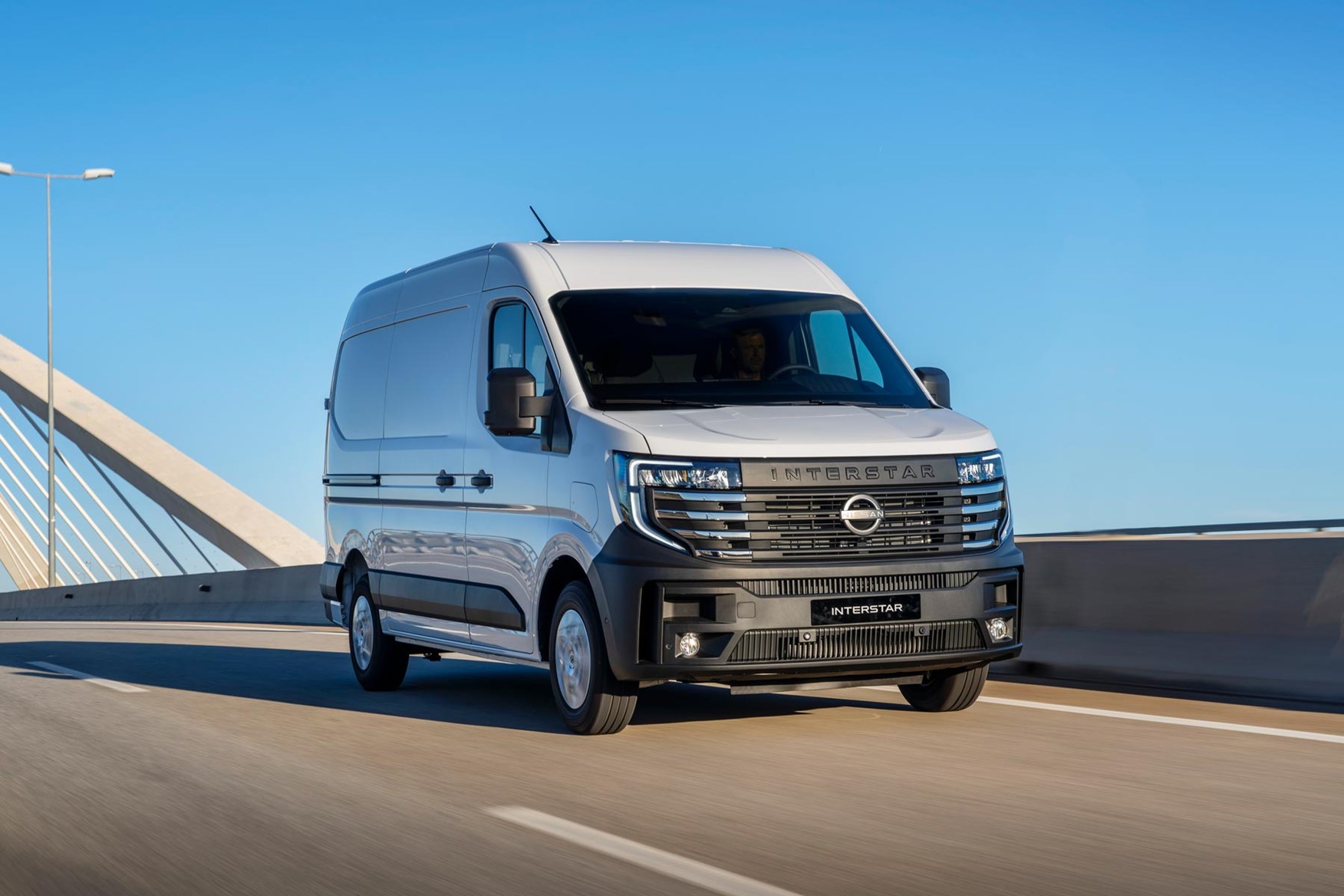
This is down to some finely-tuned improvements by the design team, who have optimised the aerodynamics, which is no mean feat with such a big and blocky van. As it slips through the air more efficiently, the motor doesn’t have to work as hard, which means it uses less battery and can go further between charges.
This brings further benefits by allowing the Interstar to allocate more of its gross vehicle weight (GVW) to payload. The electric model offers up to 1,125kg of carrying ability on the 3.5-tonne model, which naturally goes up to 1,625kg on the 4.0-tonne model. This is strong enough that it is even fractionally higher than the equivalent size diesel model, which is a notable step for an electric van as it removes one of the oft-cited barriers to EV adoption.
What are the Nissan Interstar’s rivals?
The obvious rival is the Renault Master, as the two vans are practically – but not quite – identical. More on that below.
Elsewhere in the large van class, plenty of the rivals have recently been updated in one form or another. The Stellantis quartet – the Citroen Relay, Peugeot Boxer, Fiat Ducato and Vauxhall Movano – have all been facelifted and gained larger 110kWh batteries to boost their electric capability. Toyota has chosen this point to launch its first large van, in the form of the Proace Max – a vehicle that is identical to the rest of the Stellantis crew.
The Mercedes-Benz eSprinter also has a vast new battery and a revamped cabin, while the Ford E-Transit has a new extended-range model as well.
Then there is the Maxus eDeliver 9 and the Iveco Daily, the latter of which having also recently been tweaked for 2025. The MAN TGE and Volkswagen Crafter have also both been facelifted for 2025 too, but neither offer an electric version.
What makes the Nissan Interstar stand out?
The elephant in the room for the Interstar, and the challenge for Nissan’s sales teams around the country, is the existence of the Master. Nissan has admitted that the Interstar is not like other, smaller vans created as part of a partnership. Physically, this is a Renault van with a new nose and some different badging.
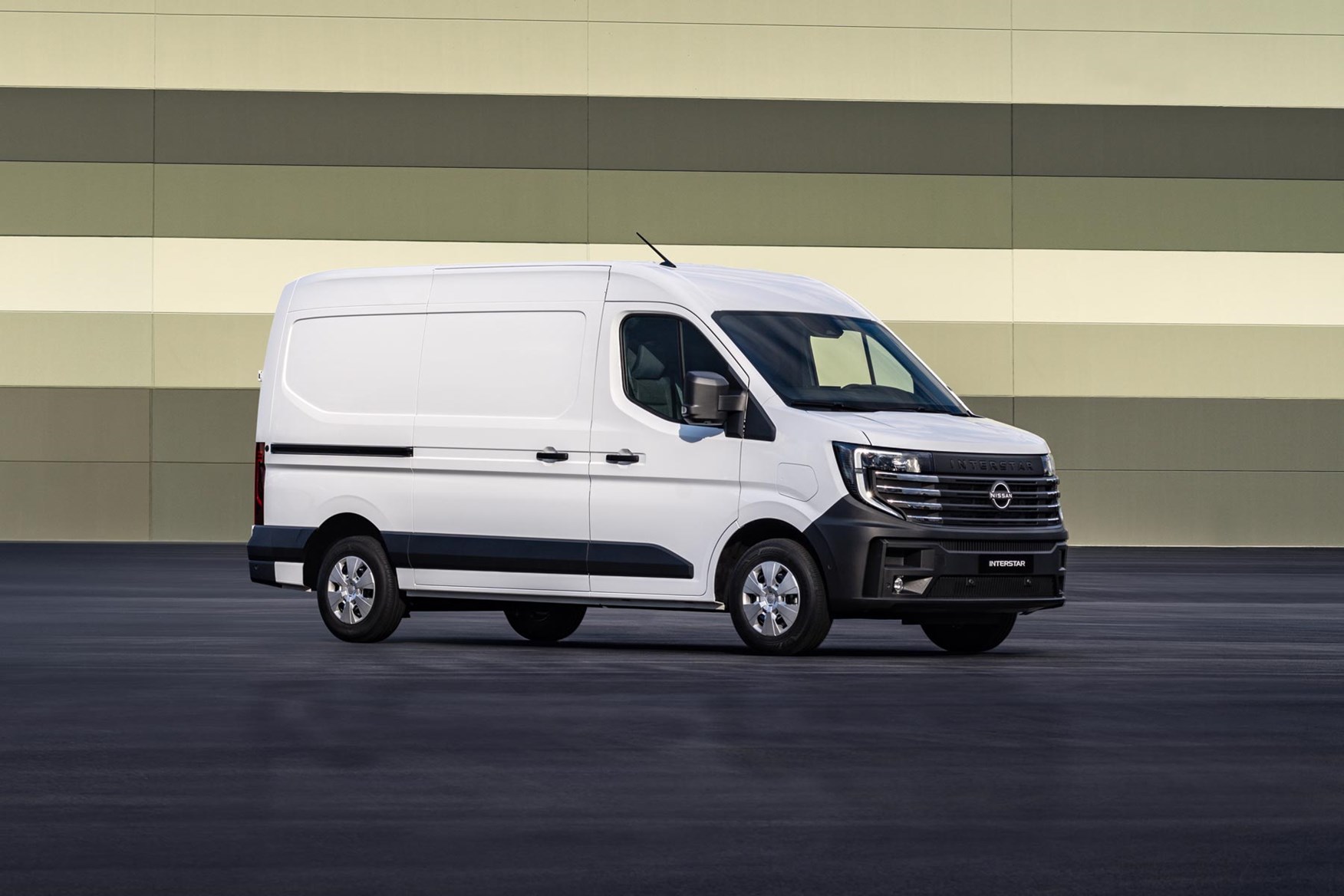
There are some differences, though, and ones that can and justifiably should entice some buyers out of a Renault dealer and into a Nissan one. The first and the most eye-catching is the five-year, 100,000-mile warranty. This is an improvement over Renault’s fairly standard three-year offering and indeed that provided by other major brands, barring Toyota with its 10-year cover on the Proace Max.
The other differences are in the versions provided. There will only be three sizes of panel van offered and two trims, but Nissan has chosen to offer all four of the available diesel engines and both of the battery options.

This gives it a wider range than the Renault as, in the UK, Renault is not bothering with the smaller battery for example. This means you can get an electric Interstar for a lower price than the Master, while the trims are also offered with fractionally more kit.
Verdict: is the Nissan Interstar any good?
Undoubtedly, yes, it is a great van, but do those small variations make it a better van than even the excellent Master? In some lights, yes, although it isn’t a clear-cut situation. Renault historically sells more commercial vehicles in the UK than Nissan, which means its dealers are more set up to deal with them and this might be a determining factor if you are a small business or solo operator. Even leaving the support network aside, though, it is a fantastic vehicle in many senses.
Skip to our full verdict on...
- Smooth to drive and simple to operate
- A choice of battery sizes
- Not that quick
The electric Nissan Interstar is technically identical to the Renault Master, so is just as good on the road, being competent rather than dazzling. That is to say that there is no surge of pace when you put your foot down, nor is there a huge amount of torque – if that is a priority then the diesels can offer more.
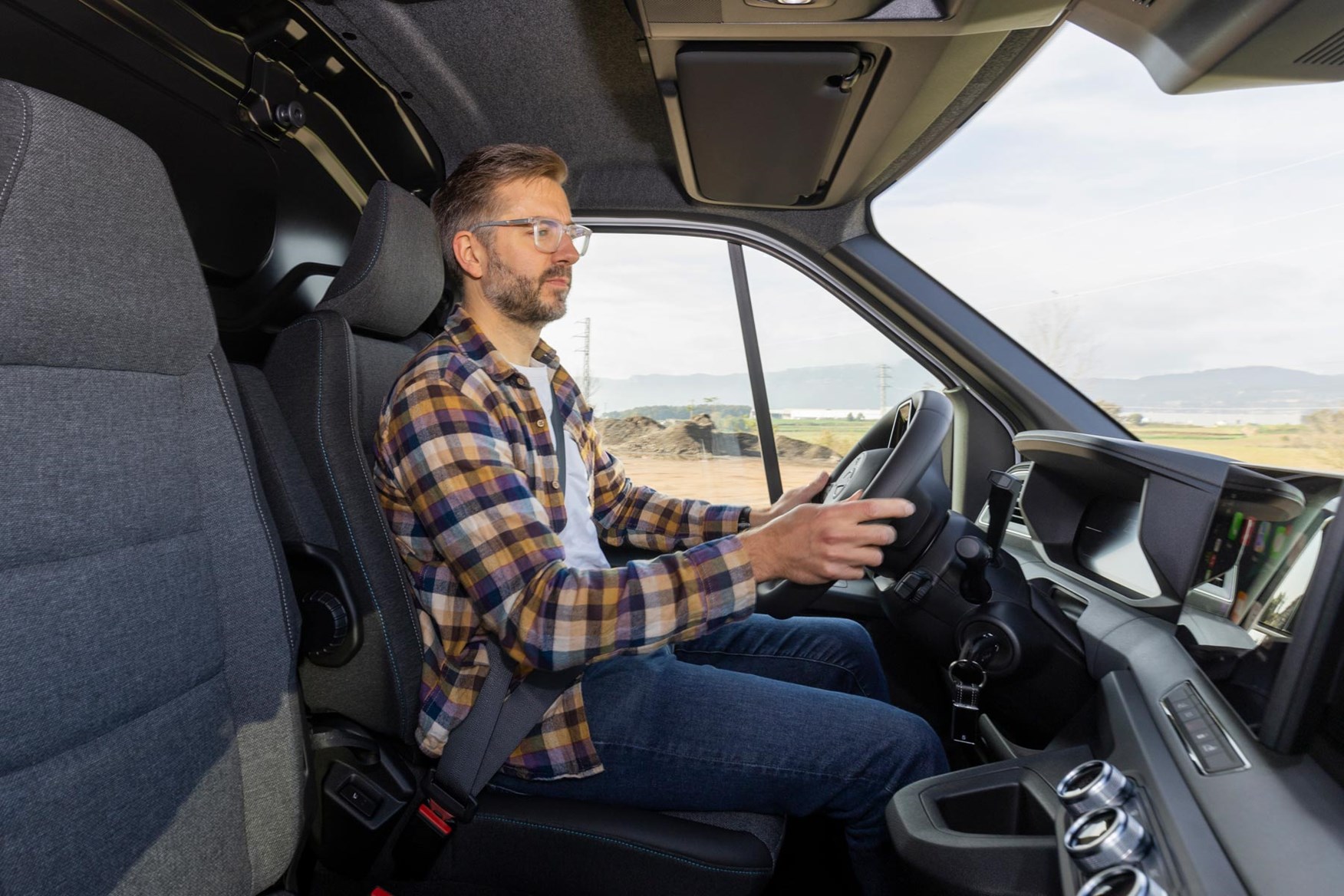
However, we were able to test it with a payload on board, and it never felt like it really struggled at any point, certainly when in normal mode. The only issue is that there are other electric vehicles – large vans included – that offer a bit more in the way of zip, both from a standstill and when going for an overtake.
Old-fashioned driving features
There are some quirks in the Interstar’s cabin, and these impact how it drives, or how you set off at least. While most electric vans allow you to leap in and press a start button and head off, the Interstar has some old-school controls that slow the process down a couple of steps.
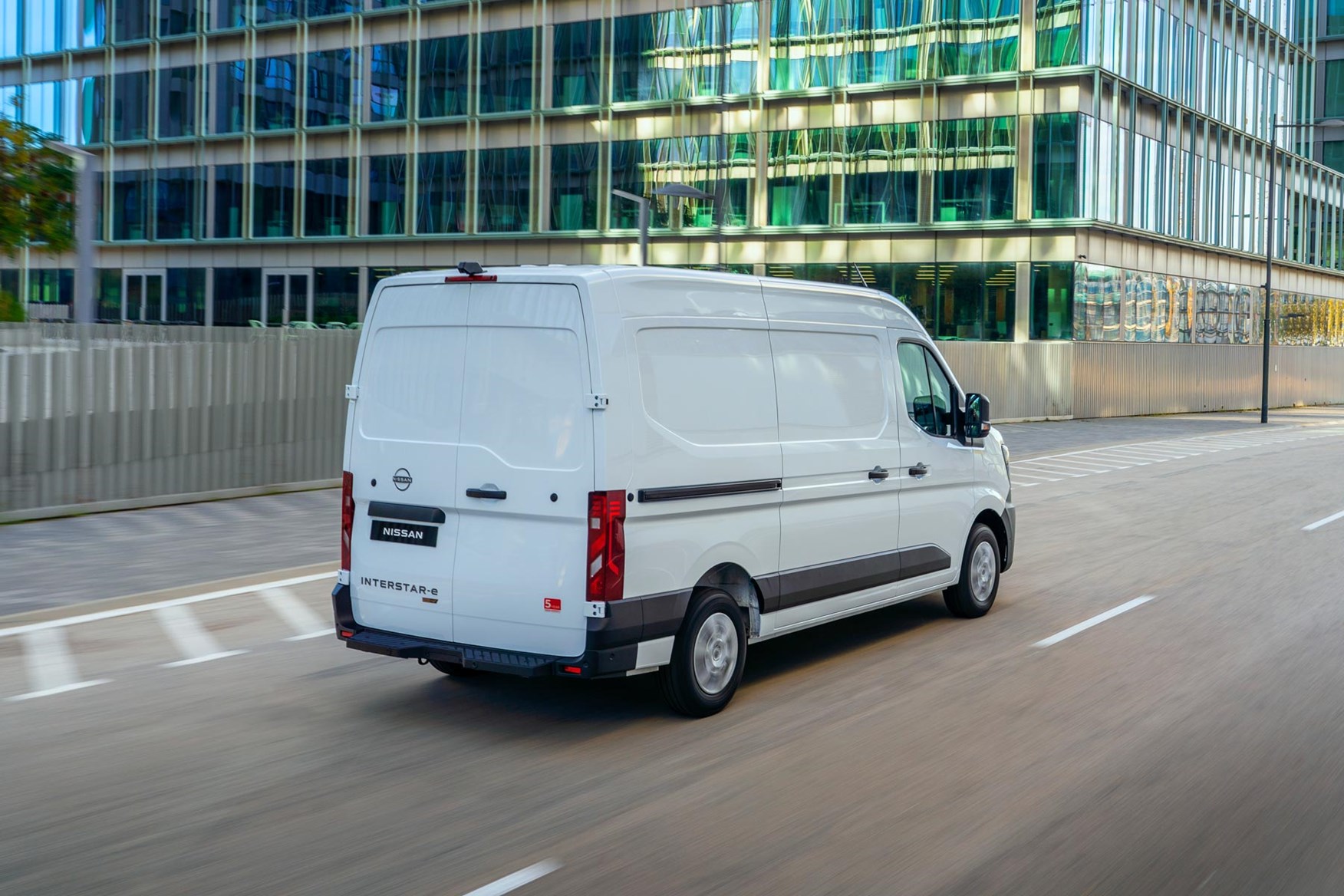
First, you need to insert a physical key into an ignition and turn it, then you need to release the manual handbrake. These are both actions that are getting rarer in diesel vehicles, let alone electric ones. While it is no major issue if you do them occasionally, the time and annoyance that the extra steps take might well add up over a long day of deliveries.
Thankfully both are tucked well out of the way, with the brake lever down between the seats, so neither impose on the cabin’s practicality.
Simple on the move
Once you’ve done that, though, the process is mercifully simple, with little in the way of complications or fiddly settings to tweak to find the best one.
There are only two driving modes, and these are activated by pressing a little ‘Eco’ button on the dashboard. This does the usual dulling down of acceleration and reducing of the top speed in order to conserve a little extra range. It does have a notable impact on performance, particularly at higher speeds, and it does eel like it will rein your right foot in if range is a priority.
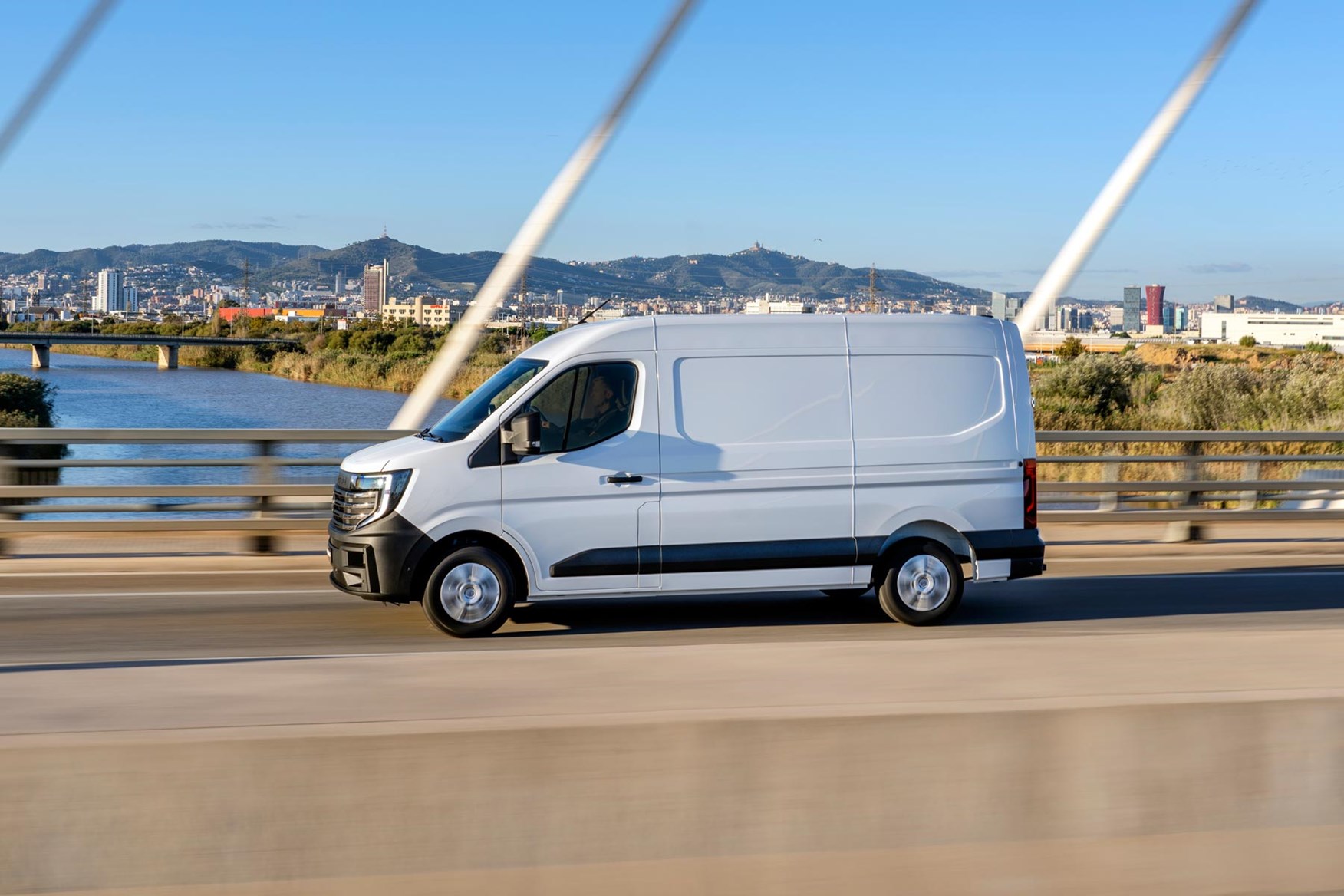
The only other setting is the ‘B’ mode that enhances the engine braking, so strictly speaking there are four combinations available but only two factors that can be changed. Far easier than having multiple different options.
The steering is light but still reactive, making for a vehicle that feels sharp to move around at high and low speeds alike. This manoeuvrability is enhanced by a genuinely impressive turning circle that is as small as 12.5m in the shortest model. It’s not London taxi levels but it is pretty good for such a big vehicle.
Visibility is impressive, which is also handy for those urban moments. The bluff, squared-off front end makes working out where the extremities of the van lie, while the windows are large and allow for a good view out of the cabin.
What is notable for the UK market is that we will only be getting a front-wheel drive version of the Interstar – there will be a rear-wheel drive model but it won’t be offered in right-hand drive.
- Some storage is great
- Other elements less so
- Plenty of room for three adults
Let’s start with another slight oddity of the Interstar’s cabin, largely because, once again, it is one of the first things you encounter. There is no handle to grab hold of to haul yourself up into the Interstar’s cabin. You might be drawn to the cupholder instead, as that is the closest thing to hand, but the good news is that you are meant to do so – it is designed to take the weight of an adult so is strong enough to act as a grab handle.
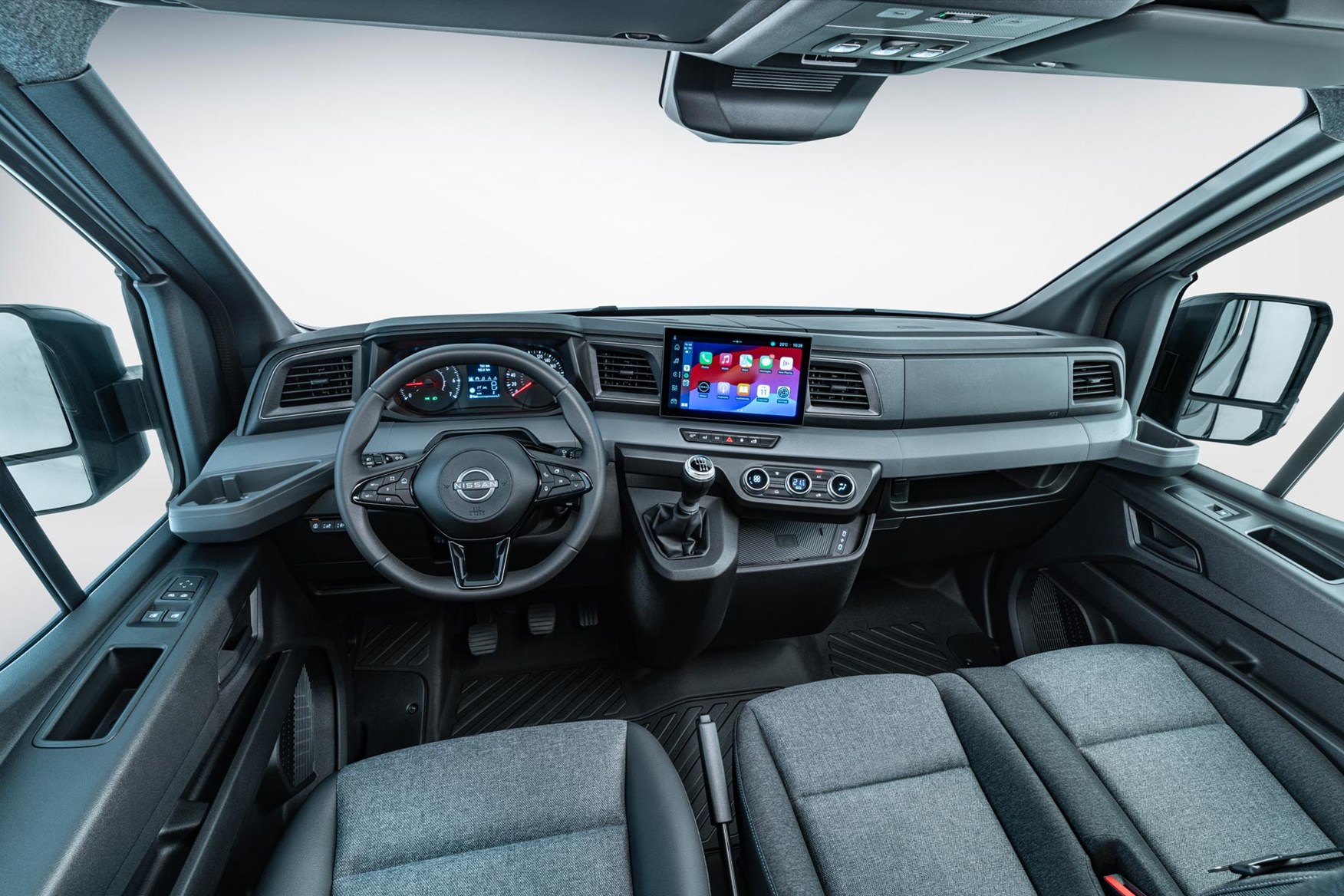
The obvious downside of this is that it is less handy if the cupholder is being used for its primary purpose – if there is a drinking vessel in there then it’s a little trickier to get the purchase you might want.
Passenger space aplenty
The rest of the compartment is comparatively modern and well laid out, the other exceptions being that unusual manual handbrake. Renault is planning an electronic one for the future, but it isn’t a major imposition on space. You just need to remember to reach for it when the van won’t pull away having automatically disengaged the brake.
Because that lever is tucked between the seats, and the gear shifter is up high on a stalk behind the wheel, there is a good amount of space for three adults across the cabin. The central passenger gets a good amount of leg room, while there is plenty of shoulder space.
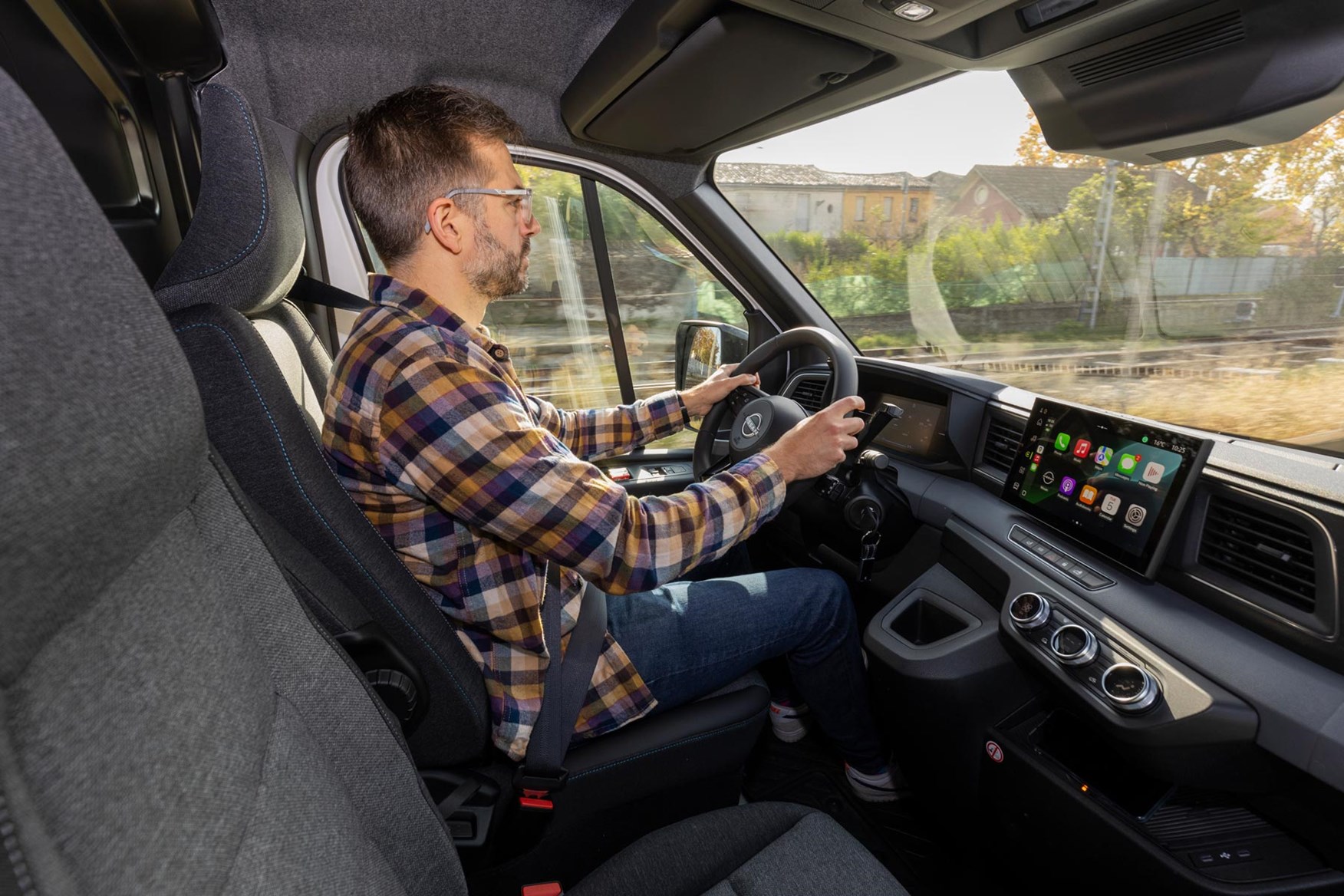
There is a little bit of dash that comes into the cabin area, and a slightly raised floor in the middle, so it isn’t quite as seamless to move from one side to the other as it is in the latest Ford Transit Custom. You have to shuffle rather than slide.
The main imposition on passenger space is the bulkhead, which is far enough forward that the seats feel a little upright, so those with poor posture might feel their seating position is a little unnatural.
Storage options throughout
There are varied storage options in the cabin, including a small overhead area, a huge space under the passenger seat and several boxes on the top of the dash. That space under the seat is best left for the charging cable, but there is room to take something else as well.
Phone cables will all have to be the more modern USB-C connections, with USB-A now confined to the past. If you have a new enough phone then the wireless charging area will suffice if you need a quick bit of battery. It’s very on display, though, which is a shame as it would be better if it were more out of sight so you don’t run the risk of being distracted by a notification or two.
One way to avoid this is to pair your phone to the main screen – Apple Carplay and Android Auto are standard – and let that do the job of alerting you to any phone interaction. The screen is sharp and easy to use, but it is a shame that everything is operated by touch. Thankfully there are some physical dials down below for the climate control, though, so that is one fewer thing that you have to take your eyes off the road for.
- Represents good value versus rivals
- Strong kit offering
- Excellent electric range for the battery size
The Nissan Interstar shines in a couple of areas that are crucial for electric vans, by being both good value for money and able to go a decent distance between charges.
Precise pricing hasn’t yet been announced for the Interstar electric, but Nissan says that it has aimed to offer a fractionally lower cash price with a bit of extra kit. The difference is marginal when it comes to the diesel versions to be honest, but in any case, the value is fantastic when looked at next to rival large electric vans.
The large battery version starts around £5,000 lower than many of the equivalents at the likes of Citroen and Peugeot for example.
Nissan Interstar electric range
Then there is the efficiency. The Interstar was designed with aerodynamics in mind, which has a knock-on benefit when it comes to how much energy it uses. The less energy it uses, the more efficient it is and the smaller the battery it needs.
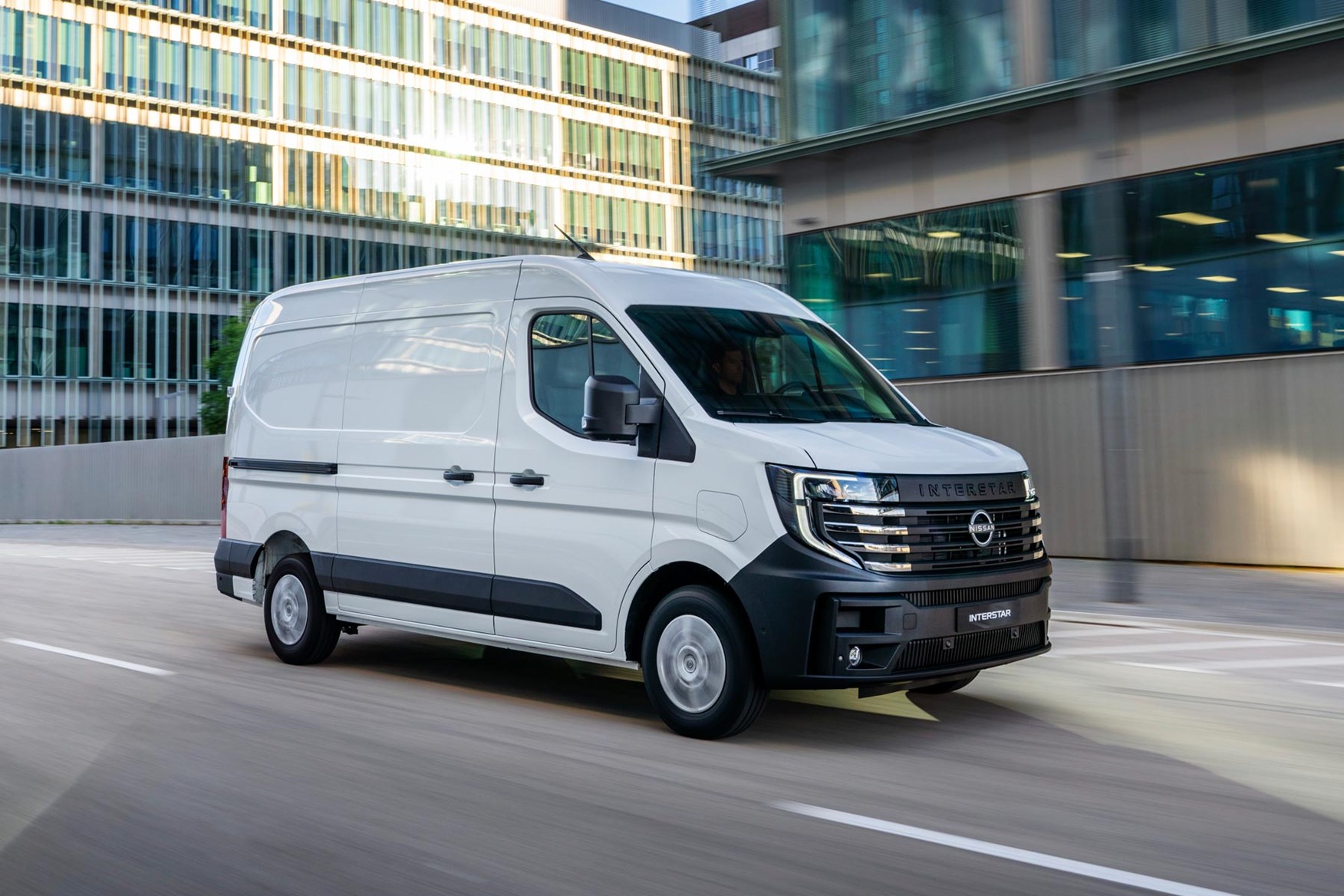
The large 87kWh battery is capable of up to 285 miles between charges, depending on which version you go for. Given the relatively simple operating system and lack of different modes it shouldn’t be too hard to get close to that, even if the full amount is ambitious with a large payload.
Nissan is also offering the smaller 40kWh battery version, which only provides a more modest range of around 112 miles. UK buyers are more likely to opt for the bigger battery, given that the 87kWh is still much smaller than many rivals and therefore leaves more weight for payload.
The bigger battery gets fast charging as standard, with up to 130kW possible from a DC charger. This should be able to provide 157 miles in half an hour, while a full charge on a 22kW AC charger will get you from 10% to 100% in less than four hours.
The smaller battery only gets 11kW AC charging and 50kW DC charging
Nissan Interstar servicing
Service intervals are set at two years or 24,000 miles, whichever comes first – exactly the same as the Renault.
Nissan Interstar warranty
The warranty is another area where Nissan has the edge over lots of the competition, including the Renault Master. It gets five years or 100,000 miles of warranty with five years of roadside assistance included as well. This is on top of the eight-year/100,000-mile cover on the battery.
Nissan Interstar standard equipment
There are only the two trims in the Interstar range, named Acenta and Tekna. The majority of kit comes with the lower of the two, so there is no bog-standard model to avoid. The highlights of the two models are below:
Nissan Interstar Acenta highlights
- Two-seater passenger bench seat
- Under-seat storage
- Heated and powered door mirrors
- 10.1-inch touchscreen with Bluetooth, wireless Apple Carplay and Android Auto
- 7.0-inch digital instrument display
- Rear parking sensors
- Manual air conditioning
- Front fog lights with cornering functions
- Towing preparation
Nissan Interstar Tekna highlights
- Two additional anchoring rings in the load bay
- 12V power in the loading area
- Lumbar support on the driver’s seat
- Heated windscreen
- 360-degree parking sensors
- Rear-view camera
- Automatic air conditioning
- Automatic lights and wipers
The newness of the Nissan Interstar makes it tricky to draw conclusions on reliability, but both Renault and Nissan have plenty of experience with the electric systems underneath.
- High level of safety kit
- Platinum Euro NCAP rating
The goal was for a top safety score, and the Interstar got the best it could aim for, with a Platinum rating from Euro NCAP. There is a wide array of new systems, all fitted as standard. This includes the following:
- Driver’s and passenger airbag
- Hill Start Assist and Trailer Sway Assistant
- Lane Departure Warning
- Lane Keeping Assist
- Automatic Forward Emergency Braking System (AEBS)
- Emergency e-Call system
- Driver drowsiness and attention warning
- Intelligent Speed Assist (Cruise Control + Traffic Sign Recognition)
Security systems include the below:
- Automatic door locking (at 5MPH)
- Anti-Theft System immobiliser
- Thatcham alarm
Which Nissan Interstar-e is best for me?
There is some choice in the Interstar range, but not loads and the decision will be easy for many. Nissan is offering the smaller 40kWh battery but the 87kWh version has a high enough payload that there isn’t a need to step down on that basis. In terms of kit, the Acenta has plenty and there isn’t much on the Tekna equipment list that would tempt us to upgrade.












